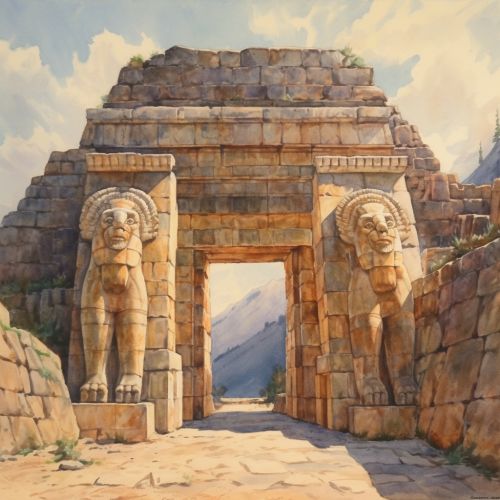Lion Gate
Introduction
The Lion Gate is a significant archaeological site, known as the main entrance of the Bronze Age citadel of Mycenae in southern Greece. It was erected during the 13th century BC, in the northwest side of the acropolis and is named after the relief sculpture of two lionesses or lions in a heraldic pose that stands above the entrance.


Architecture
The Lion Gate is a massive and imposing construction, standing 3.10 m wide and 2.95 m high at the threshold. It narrows up to 2.78 m as it rises, measuring 3.20 m below the lintel. The opening was closed by a double door mortised to a vertical beam that acted as a pivot around which the door revolved.
The gate itself consists of two great monoliths capped with a huge lintel that measures 4.5m in length, 2.0m in width, and at least 0.8m in thickness. Above the lintel, the masonry courses form a corbelled arch, leaving an opening that lightens the weight carried by the lintel. This relieving triangle is a great limestone slab on which two confronted lionesses or lions carved in high relief stand on either side of a central column. The heads of the animals were fashioned separately and are missing, but their bodies and legs are still present. The column, which is significantly smaller than the animals, is a Minoan-type column that is placed on top of an altar-like platform and is crowned with a Minoan-style bull's head.
Historical Significance
The Lion Gate was the main entrance of the Bronze Age citadel of Mycenae, the center of the Mycenaean civilization. The gate was erected in the 13th century BC and was named after the relief sculpture of two lionesses or lions in a heraldic pose that stands above the entrance. The Lion Gate is the sole surviving monumental piece of Mycenaean sculpture, as well as the largest sculpture in the prehistoric Aegean.
It is believed that at the time of its construction, the Lion Gate was the largest and most imposing monument in the western world. Its design was imitated in many other administrative buildings of the Mycenaean world, such as the Treasury of Atreus and the walls of Tiryns.
Interpretation and Symbolism
The lionesses or lions that flank the central column of the Lion Gate are believed to be a symbol of the Mycenaean rulers and a clear expression of their power. It also is likely that they were designed as a deterrent against invaders, to give an impression of strong and mighty kings who ruled this world. The absence of the heads, which were probably made of precious materials, is unfortunate, as they would have certainly added to the majestic image of the gate.
Excavation and Preservation
The Lion Gate was first excavated by archaeologist Heinrich Schliemann in 1876, following the descriptions of Pausanias who visited Mycenae in 160 AD. In the process of the excavation, Schliemann discovered the shaft graves under the 'agora' in the Acropolis, where a hoard of gold artifacts was found. The Lion Gate itself was found to be part of a larger cyclopean wall that enclosed the palace and graves.
The site is currently maintained by the Greek Ministry of Culture, although there has been much debate over the restoration of the site. In the early 2000s, the Lion Gate and the walls of Mycenae were listed as a UNESCO World Heritage Site, and they are open to the public for visitation.
